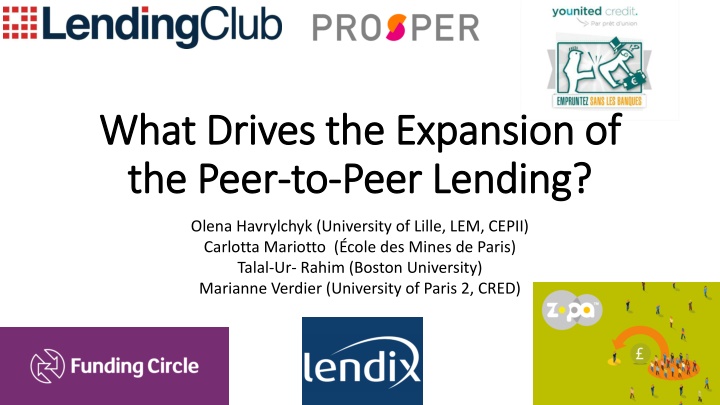
The Growth Drivers of Peer-to-Peer Lending
Explore the factors behind the expansion of peer-to-peer lending, including the role of P2P platforms, borrower preferences, regulatory challenges, and market significance. Discover how P2P lending compares to traditional banking and its impact on the financial landscape.
Download Presentation

Please find below an Image/Link to download the presentation.
The content on the website is provided AS IS for your information and personal use only. It may not be sold, licensed, or shared on other websites without obtaining consent from the author. If you encounter any issues during the download, it is possible that the publisher has removed the file from their server.
You are allowed to download the files provided on this website for personal or commercial use, subject to the condition that they are used lawfully. All files are the property of their respective owners.
The content on the website is provided AS IS for your information and personal use only. It may not be sold, licensed, or shared on other websites without obtaining consent from the author.
E N D
Presentation Transcript
What Drives the Expansion of What Drives the Expansion of the Peer the Peer- -to to- -Peer Lending? Peer Lending? Olena Havrylchyk (University of Lille, LEM, CEPII) Carlotta Mariotto ( cole des Mines de Paris) Talal-Ur- Rahim (Boston University) Marianne Verdier (University of Paris 2, CRED)
Banking is necessary; banks are not Banking is necessary; banks are not Bill Gates, 1990 P2P/marketplace lending is a new form of (dis)intermediation Prosper: variable rate model (Dutch auction) from 2006 to 2009 and fixed interest rate afterwards. Lending Club: fixed interest rate
Borrowers use P2P platforms mostly for debt consolidation A typical borrower is a wealthy individual with high level of debt (Morse, 2016)
P2P lending growth in the US (in billions of dollars) Launch of P2P lending platforms in 2006 (Prosper) and 2007 (LC) Prosper and LC closed in 2008 due to the regulatory uncertainty (selling of unregistered securities) and litigation In 2008-2009, platforms reopen after SEC registration. 2012 and 2014: LC and Prosper become profitable 2014: LC goes public
How important is P2P lending? Very small in % of total bank lending But in some niche markets, it becomes very important. In 2015, the US online alternative finance consumer lending was equivalent to 12.5% of traditional consumer lending (Wardrop et al., 2016). In 2015, 12% of UK small business loans and 16% of venture and seed capital came from P2B and equity crowdfunding platforms (Wardrop et al., 2016).
P2P vs traditional banks Borrowers perspective: final product is the same a loan. Lenders perspective: platforms and banks do not offer the same services No liquidity provision No delegated monitor Banks enjoy funding costs due to explicit and implicit govt. guarantees P2P platforms use new technology to operating costs and to price risks and do not have legacy problems, aggravated by the crisis In 2016, Zopa has applied for a banking license.
What are the main drivers of the expansion of the P2P lending? H1: Competition-related hypothesis
What are the main drivers of the expansion of the P2P lending? H1: Competition-related hypothesis H2: Crisis-related hypothesis
What are the main drivers of the expansion of the P2P lending? FRED Graph H1: Competition-related hypothesis H2: Crisis-related hypothesis H3: Technology-related hypothesis
Identification strategy relies on the geographic geographic heterogeneity
Main Main dataset dataset: : loan loan books of Prosper and LC books of Prosper and LC LC and Prosper transaction level data aggregated at the county level for 2006-2013 Dep. variables: (1) Volume of P2P lending; (2) N. of loans per capita 2006 2007 2008 2009 2010 2011 2012 2013 Lending Club Volume (in mln $) N. of counties N of. Loans 0 0 0 2 13 379 46 676 116 987 1359 257 718 1836 2064 2384 110 246 1488 4500 10594 19861 49811 137824 ProsperProsper Volume (in mln $) N. of counties N. of loans 29 81 69 9 27 75 154 1739 217 1721 21990 673 6145 11592 11683 2118 1175 1377 631 1029 1397 5864 11508 20054
Estimation with SARAR model Spatial autoregressive model with a spatial autoregressive disturbance ??= 0+ ???+ 1 ??????????? + ?2 ?????? + ?3 ?????????? + ? + ui; where n with i~N 0, 2I ui= wijuj+ i, j=1
Does geography explain P2P lending? Various channels of spatial interdependence Theory of human interactions (Comin et al., 2012) and technology diffusion Regional business cycles and economic shocks Policy coordination Boundary mismatch problems when the economic notion of a market does not correspond well with the county boundaries (Rey and Montouri, 1999). Regional disparities for which we do not control with our right-hand variables
Measuring the depth of the crisis Failed banks: % of deposits affected by bank failures in a county Crisis Leverage: The average leverage ratio of deposit taking institutions present via branches in a county, during crisis years Crisis Tier 1 capital: The average Tier A capital ratio of deposit taking institutions, during crisis years Credit rationing: change in Credit Card Debt Balance per Capita during crisis years Delinquencies: % of Credit Card Debt Balance 90+ Days Delinquent during crisis years
Measuring competition by market structure HHI: Herfindahl-Hirschmann index, computed in terms of deposits C3: The share of deposits of the three largest deposit taking institutions in a county Branches per capita: Number of branches in a county divided per 10 000 population Pay Day loans: Number establishment divided by 10 000 population.
Measuring technology Broadband: % of county population with access to any broadband technology (excluding satellite) Mobile: % of county population with access to Mobile Wireless (Licensed) technology Speed: % of county population with access to upload speed 50 mbps or higher Patents: Number of patents per 10 000 population
Controlling for socio-economic characteristics Age 20 to 34: The share of the population between 20-34 years Population density: Population number divided by area in sq. m. in a county Bachelor: % of county population with at least bachelor education Poverty: % of county population below poverty line Black: % of Afro-Americans in the county population Hispanic: % of Hispanic population in the county population Asian: % of Asian population in the county population State level dummies
Conclusions: What are the main drivers of the P2P lending? Low level of branch density and banking concentration Due to lower presence of traditional banks and lower brand loyalty? Presence of educated, innovative and wealthy population Presence of ethnic minorities (black and hispanic) Due to discrimination by traditional bank? Spatial diffusion plays an important role Neither crisis variables nor internet matter






















